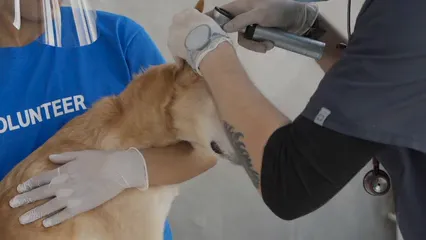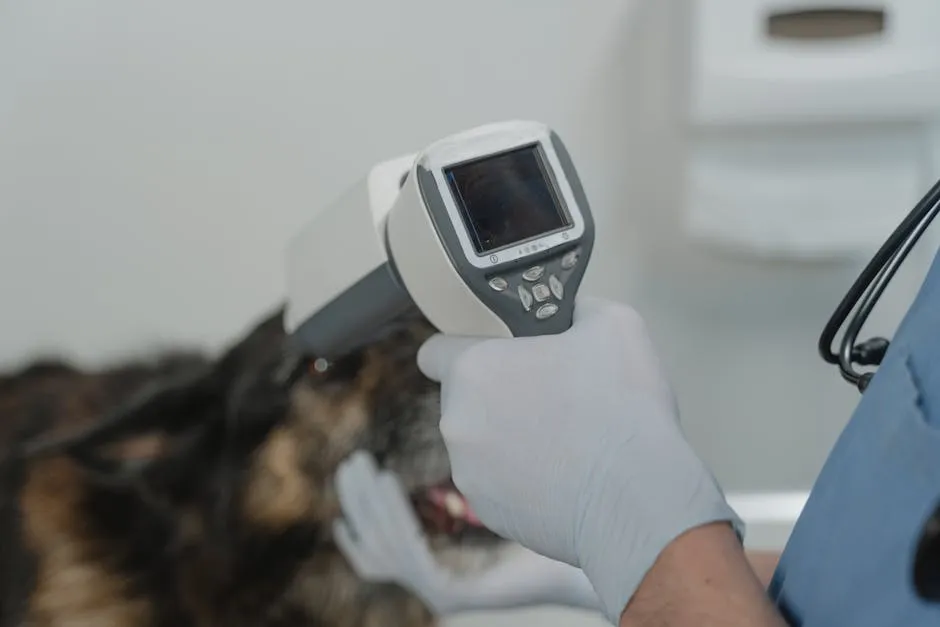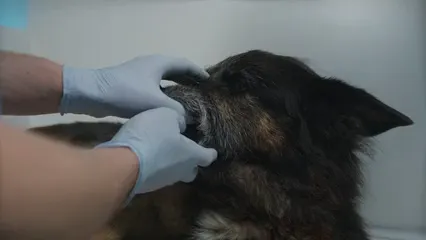Introduction
Vestibular disease in dogs is a common condition. It affects their balance and coordination. This illness can appear suddenly, leading to confusion for pet owners. Many may mistake it for a stroke because of similar symptoms. Recognizing the signs early is vital. If your dog shows any symptoms, seek veterinary advice promptly.And while you’re at it, ensure your furry friend is well-fed with the Blue Buffalo Life Protection Formula Dog Food. It’s packed with wholesome ingredients, ensuring your dog stays healthy and strong while navigating their vestibular challenges.

Summary and Overview
Vestibular disease refers to problems in the vestibular system, crucial for balance. This system helps dogs maintain their posture and orientation. It’s most common in older dogs, but younger ones can also be affected. Many cases are idiopathic, meaning the cause is unknown. Common symptoms include head tilt, stumbling, and disorientation. Diagnosis often involves a physical exam and tests to rule out other conditions. Treatment depends on the underlying cause but may include supportive care and medication.To keep your dog comfortable during their recovery, consider the PetFusion Ultimate Dog Bed. It provides the support they need to rest comfortably as they recover.

What is the Vestibular System?
The vestibular system is a complex structure responsible for maintaining balance and spatial orientation. It consists of components in the inner and middle ear, along with areas in the brain. The inner ear contains semicircular canals filled with fluid that detect head movement. These signals travel to the brain, which interprets them and helps coordinate movement. A dysfunction in this system can lead to vestibular disease. When the vestibular apparatus fails, dogs may experience dizziness, loss of balance, and difficulty walking. This disruption can stem from infections, trauma, or age-related degeneration. Understanding this system is crucial for diagnosing and treating vestibular disease effectively.And speaking of balance, keeping your dog engaged is essential! Check out the KONG Classic Dog Toy. It’s not just a toy; it’s a way to keep them mentally stimulated while they recover!

Common Symptoms of Vestibular Disease in Dogs
Dogs with vestibular disease often show clear signs. One of the most noticeable symptoms is a head tilt. You might see your dog leaning to one side, which can seem unusual. This head tilt can lead to ataxia, or a staggering gait, making it difficult for them to walk straight. Stumbling is another common behavior. Affected dogs may appear disoriented, struggling to maintain balance. Nystagmus, or rapid eye movements, can also occur, making it seem like they are dizzy. You might notice your dog vomiting or drooling due to the discomfort. Lastly, disorientation is evident; they may walk in circles or seem confused about their surroundings. These symptoms often appear suddenly, which can be alarming. They may progress rapidly, leading to increased difficulty in movement. Recognizing these signs early is crucial for getting proper veterinary care.
Causes of Vestibular Disease
Vestibular disease in dogs can arise from various factors. One common cause is ear infections, particularly otitis media or interna. These infections can disrupt the vestibular system, leading to balance issues. Another potential cause is tumors within the ear or surrounding areas. Such growths can put pressure on nerves that affect balance. Hypothyroidism is yet another factor, as low thyroid hormone levels can impact multiple body systems, including balance. Sometimes, the cause remains unidentified, referred to as idiopathic vestibular syndrome. This condition often affects older dogs suddenly but doesn’t worsen over time. It’s essential to differentiate between peripheral causes, like ear infections, and central causes, which involve brain-related issues. Certain breeds, including German Shepherds and Doberman Pinschers, are more predisposed to vestibular disease. Age also plays a role; older dogs are significantly at risk for developing this condition. Understanding these causes can help in early diagnosis and effective treatment.
Diagnosis of Vestibular Disease
Diagnosing vestibular disease in dogs involves several steps. First, your veterinarian will take a thorough medical history. They will inquire about your dog’s symptoms, including when they started and their progression. Next, a clinical signs assessment is performed. This includes observing any head tilt, staggering, or disorientation. A physical examination is crucial. The vet will check the dog’s neurological function and balance. This helps determine whether the issue is central (brain-related) or peripheral (ear-related). In some cases, additional diagnostic tests may be necessary. Blood tests can help rule out infections or metabolic disorders. Imaging techniques like MRI or CT scans are used to identify tumors or significant ear problems. These tests provide a clearer picture of the underlying issues. Differentiating between vestibular disease and other neurological problems is vital. Dogs can exhibit similar symptoms for various conditions, such as strokes or trauma. Therefore, an accurate diagnosis is key to effective treatment. Your vet’s expertise is invaluable in this process.
Treatment Options for Vestibular Disease
Treatment for vestibular disease largely depends on its underlying cause. If an infection is present, your vet may prescribe antibiotics to combat it. For dogs experiencing nausea, medications can help ease this discomfort. Supportive care is essential, especially in severe cases where hospitalization may be required. Intravenous fluids may be necessary to keep your dog hydrated. Dogs that struggle to eat or drink will benefit from this treatment. In less severe situations, home care might suffice. Providing a quiet, comfortable space for your dog to rest is crucial.Speaking of comfort, don’t forget to check out the PetSafe Healthy Pet Gravity Feeder. It ensures your dog has access to food without the hassle, especially when they need to focus on recovery.

Home Care and Nursing for Dogs with Vestibular Disease
Caring for a dog with vestibular disease at home is crucial for recovery. Start by creating a safe environment. Remove any obstacles that could cause your dog to trip or fall. Use non-slip mats to help your dog navigate safely on slippery floors. Feeding your dog can be challenging if they struggle to stand. Consider using elevated bowls or hand-feeding to make mealtime easier. Keeping food and water within easy reach can encourage them to eat and drink. Helping with mobility is also essential. Support your dog during walks using a harness or sling. This can prevent falls and provide necessary stability. If your dog has difficulty going outside, assist them by using a towel under their belly for support.For those moments when your pup needs a little extra comfort, the Snuggle Puppy Heartbeat Stuffed Toy can be a great companion. It mimics the comforting sound of a heartbeat, helping them feel less anxious during recovery.

Understanding how to provide effective home care is essential for dogs with vestibular disease.
Prognosis and Long-term Outlook
The prognosis for dogs with vestibular disease is generally positive. Many dogs begin to show improvement within a few days. Most recover fully within two to three weeks. However, individual recovery times can vary. Several factors influence recovery time. Age, overall health, and the severity of symptoms play significant roles. Younger dogs often recover faster than older ones. Dogs with underlying health issues may also experience longer recovery times. Some dogs may exhibit long-term effects after recovery. A common residual symptom is a head tilt, which may persist. While this can seem concerning, it typically does not affect their quality of life. With proper care, dogs can continue to lead happy, fulfilling lives, even with minor ongoing symptoms.
Conclusion
In this article, we covered vestibular disease in dogs, a condition affecting balance and coordination. We discussed its sudden onset and how it can be misinterpreted as a stroke. Recognizing symptoms, such as head tilt and stumbling, is crucial for early diagnosis. Prompt veterinary intervention can significantly improve outcomes.Also, don’t forget about dental health! Consider using Vet’s Best Dog Toothpaste to keep those pearly whites healthy!
If you notice any symptoms in your dog, don’t hesitate to consult your veterinarian. Early treatment can make a difference in your pet’s recovery. Your dog’s health is a priority, and seeking professional advice ensures they receive the best care possible.
FAQs
What should I do if my dog shows symptoms of vestibular disease?
If your dog displays vestibular disease symptoms, contact your veterinarian immediately. They may recommend an emergency vet for dogs, especially if symptoms worsen or include vomiting.
Is vestibular disease in dogs curable?
While some cases resolve naturally, treatment for canine vestibular disease depends on the underlying cause. Recovery from vestibular disease can occur, but it may vary based on your dog’s health and the specific condition.
How can I help my dog recover at home?
Home care for dogs recovering from vestibular disease includes creating a safe environment, providing easy access to food and water, and supporting sick pets during walks. Ensure your dog is comfortable and monitor their progress.
What are the long-term effects of vestibular disease in dogs?
The long-term prognosis for dogs with vestibular disease varies. Some may experience residual effects like a head tilt, while others fully recover. Regular veterinary check-ups can help manage any ongoing issues.
Can younger dogs get vestibular disease?
Yes, vestibular disease in young dogs can occur, although it is more common in older dogs. Causes of vestibular symptoms in younger dogs may include infections or congenital issues. Always consult your vet for diagnosis and care.
Please let us know what you think about our content by leaving a comment down below!
Thank you for reading till here 🙂
All images from Pexels





